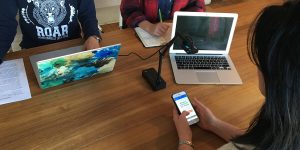Understanding User Behavior During Product Development: A Brief Guide
- Mobile
- January 29, 2019
In a globalized business environment, product design is one of the most relevant aspects of discussion for brands. Today, the term product encompasses something more than material goods. Designing digital products such as websites and apps call for a behavioral approach. Understanding the psychology and behavior of your target groups holds the key to success.
Customers today exist in an experience economy. A positive experience can create brand advocates from individual customers. Over the last few years, it is evident that brands are investing more efforts, money, and time to personalize the product experience.
During product development, brands need a lucid insight into the expectations and aspirations of the target group. They have dedicated UX groups, who tract the customer journeys of individual buyers. Besides, they carry out focus groups to ensure that the customer expectations and product designs are aligned together.
Designing a Product: The Initial Stages
Before developing the product design, brands need to be clear about the features and utility. Focusing on the business objectives, you need to think of the following aspects:
- What problem is being encountered?
- Who is facing this problem?
- What can we do to resolve the same?
Forward-thinking companies hire design experts, who help them develop a compelling strategy for designing the user experience. However, understanding user behavior continues to be the initial step, before they can strategize their plan.
In this article, you will come across certain tips that will give you a better understanding of user behavior during product development.
User Behavior Principles Every Brand Must Know
In the competitive business environment, errors in product engineering can prove to be fatal. Buyers are often unforgiving, which makes it necessary for firms to understand user behavior. Brands are able to make smarter choices about their mobile apps, SaaS applications, websites and other products, when they are more informed about their user behavior.
Focus on Utility: The Product Should Solve a Problem
Firstly, you need to prioritize the utility of your product. It must solve a real-world problem. Successful brands have been successful in perceiving the issue from the perspective of the users. They develop the product with a dedicated purpose, which can deliver a relevant and personalized experience to the users. Every time the customers interact with the product, they can realize this benefit.
For a marketer, it is important to quickly convey the value of the product to the customers quickly. When you focus on the utility of your product, make sure that it adds value to the life of the buyers.
Usability Testing, User Interaction and Analytics
For most users, the experience and product are often the same. Every interaction that the user has with your product should be potential enough to make your product smarter. Therefore, it is necessary to have a clear understanding of the user interactions from the very early stage of a product lifecycle.

If you are a startup, or entering a new market, user testing and studying user interaction are crucial measures. Besides, you should focus on analytics that will generate a better understanding of user behavior. The utility of your product should reflect the aspirations and needs of end users.
Seeking User Feedback
Understanding user behavior involves studying the feedback of the users. Every brand needs to come up with a seamless mechanism, that enables them to get understand the reactions of their buyers. Regardless of what you have chalked out, users may show unexpected ways of behavior. They may switch brands and look elsewhere for an experience they want.

Evidently, you need to aggregate the feedback from your customers from several sources. Presently, business firms count on campaign data, offline data, digital analytics information, third-party information or offline data to develop a comprehensive review of the feedback.
Let’s consider the instance of Google. With the increasing volume of information in smartphones, people started running out of spaces to store information. The company introduced ‘Google Photos’ that helps users free up space.
Previously, the feature called ‘Free My Space’ was placed in the settings. This was moved to a more conspicuous place in the app. Eventually, people started using the product, and even today it is driving a greater number of installs.
Read also: How to Improve the User Experience of your Mobile App
Focusing on Attention Span
While developing a product, it is important to ensure it will retain the attention of the customers for an adequate duration. When the attention span is short, the efforts to retain the attention need to be intensified.
When a brand is in the initial stages of product lifecycle, the data available may not be adequate. You need to start collecting the feedback of your users and grow an insight on how they are enjoying your product.
In the subsequent stages of the product lifecycle, you need to work on making the product compelling enough. It is evident that analytics, together with usability testing, enables a brand to develop the product.
Focusing on the attention span, you can identify the patterns and trends. This will present you with a broader picture, based on which you can plan further. Various tools are available to locate checkout abandonment, sessions, bounce rates and navigations.
Understanding User Behavior and Solving Problems in 5 Stages
While understanding your user psychology, you should remember that humans possess a myriad of fluctuating behavior. It is difficult to track changes in the behavior of your customers. Besides, you have ‘external factors’ affecting the purchase mechanism. Solving the problem that the users are facing involves five stages:
1. Emphasize
At the outset, a brand needs to research and learn about the target group for whom they are designing the product. For a deeper understanding of the customers, they need to conduct a deeper research.
2. Define the Goals
Once you know the crisis areas, you need to develop your perspective, based on the insights and needs of your users. This is the first stage of product development. Remember, it should be aligned with the aspirations of the users.
3. Ideate the Solution
This process involves brainstorming and coming up with creative ideas. Most brands generate a great range of solutions, providing the necessary freedom to their teams.
4. Develop the Prototype
Once you strike a solution, design a series of prototype, or even a single prototype, that can test the hypothesis. This will ensure whether or not you are on track. If not, you may come up with fresh ideas.
Read also: Thinking of Prototyping a Mobile App: Just Follow the Step by Step Procedure
5. Get the Feedback
Once your product hits the market, make sure to get feedback from your customers. The process of product development is evolutionary and continuous. With new innovations in the industry, you need to upgrade the products. At the same time, it is important to focus on the feedback and integrate new features in your product.
This process ensures you remain competitive in the market. Failure to interpret user behavior leads to low retention rates. Besides, with digital products, the user engagement suffers a dip. Regardless of where you are in your business cycle, you need to grab the attention of potential buyers and influence their decisions. This makes purchasing your products a habit for them.
Developing successful products involve a good understanding of the user behavior. Make sure to invest adequate time, so that your products can deliver memorable experiences to the target groups.













